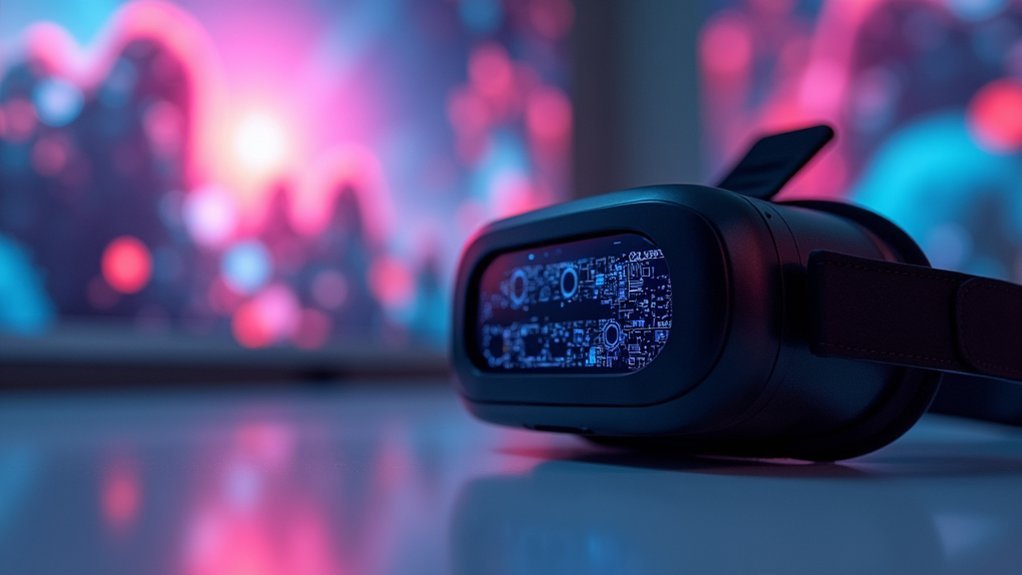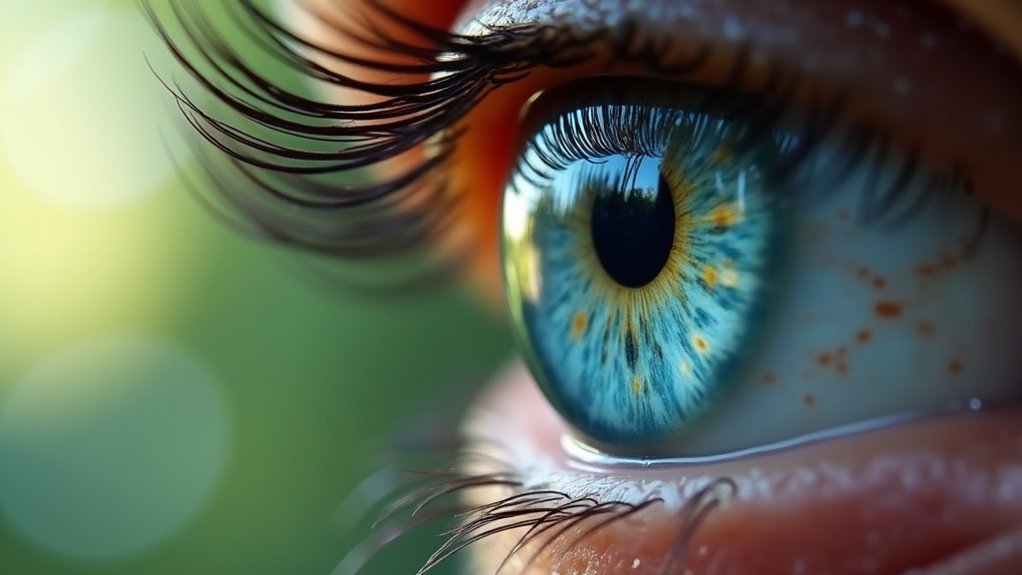Foveated rendering revolutionizes vision by perfectly matching how your eyes naturally work—concentrating processing power where you’re looking while reducing detail in peripheral areas you don’t consciously notice. This breakthrough technology cuts GPU loads by up to 72% without sacrificing visual quality, maintains essential 90+ FPS performance, and extends battery life in VR devices. You’ll experience seamless visuals with real-time gaze tracking that adapts instantly to your eye movements, opening possibilities far beyond gaming.
Understanding the Science Behind Human Vision and Foveated Technology

When you look at the world around you, your eyes don’t capture everything with equal clarity—instead, they create a sophisticated visual hierarchy that prioritizes detail where it matters most. Your fovea, the central region of your retina, resolves approximately 60 pixels per degree, delivering sharp detail for whatever you’re focusing on.
Your eyes naturally create a visual hierarchy, delivering crisp detail only where you focus while sacrificing clarity everywhere else.
Meanwhile, your peripheral vision trades resolution for motion detection and spatial awareness.
Foveated rendering mimics this natural system by concentrating computational power where you’re actually looking. Through eye tracking technology, systems can identify your gaze direction in real-time and allocate rendering resources accordingly.
This creates high-quality visuals in your central field while reducing detail in areas you’re not actively observing, perfectly matching how your visual system naturally processes information.
How Dynamic Eye Tracking Transforms Rendering Performance
You’ve seen how your eyes naturally focus on specific areas, and now dynamic eye tracking technology harnesses this biological process to revolutionize rendering performance.
When sophisticated sensors detect exactly where you’re looking in real-time, the system can instantly adjust computational resources to match your gaze patterns.
This creates dramatic performance optimization benefits by concentrating high-quality rendering power precisely where you need it most while reducing unnecessary processing in your peripheral vision.
Real-Time Gaze Detection
As your eyes dart across a virtual landscape, real-time gaze detection systems capture these movements with millisecond precision, fundamentally transforming how rendering engines allocate computational resources.
Dynamic foveated rendering leverages this instantaneous tracking to deliver high-resolution graphics exactly where you’re looking while reducing quality in peripheral areas you can’t perceive clearly.
Modern eye-tracking hardware achieves this breakthrough by monitoring your pupil movements and calculating gaze direction in real-time.
You’ll experience reduced GPU loads up to 72% without sacrificing visual fidelity, enabling mid-tier systems to maintain vital 90+ FPS performance.
This prevents motion sickness while extending battery life in standalone VR devices.
The result? You get visually stunning experiences without requiring excessive computational power, making immersive VR accessible across broader hardware configurations.
Performance Optimization Benefits
While traditional rendering engines struggle to maintain performance across entire displays, dynamic eye tracking revolutionizes this approach by intelligently redistributing computational workloads based on your actual gaze patterns.
This performance optimization reduces GPU shading load by up to 72%, enabling mid-tier hardware to achieve stable frame rates above 90 FPS without compromising visual quality.
When you’re using VR or AR devices, foveated rendering helps concentrate resources on your focus area while reducing detail in peripheral vision.
This targeted approach notably lowers power consumption, extending battery life in standalone headsets.
You’ll experience seamless shifts without perceiving quality loss, while freed-up GPU resources enhance complex visual effects exactly where you’re looking, delivering superior immersion in gaming and training applications.
Static Vs Dynamic Foveated Rendering: Key Technical Differences

Two distinct approaches to foveated rendering offer dramatically different user experiences and performance outcomes.
Static foveated rendering fixes predefined zones across your screen, maintaining 100% resolution in the center while reducing quality in surrounding areas regardless of where you’re looking. This creates peripheral distortion since it doesn’t track your natural eye movements.
Dynamic foveated rendering actively follows your gaze in real-time, ensuring whatever you’re focusing on receives full resolution while dynamically adjusting surrounding areas.
You’ll experience up to 72% GPU shading load reduction while maintaining 90+ FPS. However, dynamic systems require precise, low-latency eye tracking technology, making implementation more complex.
The trade-off between static simplicity and dynamic effectiveness determines which approach best suits your specific virtual environment needs.
GPU Resource Optimization Through Intelligent Gaze Detection
When your GPU intelligently detects where you’re gazing, it revolutionizes resource allocation by concentrating rendering power exclusively on your focal point. This foveated rendering approach delivers extraordinary gpu resource optimization, reducing pixel processing by 30-50% while maintaining crystal-clear vision quality.
Your GPU’s shading load drops up to 72% through dynamic gaze detection, ensuring stable 90+ FPS performance critical for smooth VR experiences.
Real-time eye tracking enables precise adjustments, delivering high-resolution detail exactly where you’re looking while intelligently reducing peripheral quality without noticeable distortion.
This optimization makes your GPU run cooler and consume less power, extending battery life in standalone devices.
You’ll gain freed resources for complex visual effects in focus areas, while advanced GPU capabilities like Adreno processors enhance overall performance and visual fidelity.
Real-Time Performance Benefits in VR and AR Applications

Because foveated rendering delivers real-time performance optimization, you’ll experience transformative improvements in both VR and AR applications that fundamentally change how immersive content performs.
You’ll see frame rates consistently exceed 90 FPS, eliminating motion sickness while your GPU’s shading load drops by up to 72%. Your mid-tier hardware now achieves high resolution visuals that previously required premium components.
Mid-tier hardware now delivers premium performance with 90+ FPS frame rates and 72% reduced GPU load through intelligent rendering optimization.
The system tracks your user’s gaze in real-time, concentrating rendering power where you’re looking while reducing detail in peripheral areas.
You’ll notice extended battery life in standalone VR devices as power consumption decreases considerably. This intelligent resource allocation means you’re getting superior visual fidelity in focused areas while maintaining smooth performance across the entire experience, dramatically improving your satisfaction during VR and AR sessions.
Power Efficiency and Battery Life Extensions for Wearable Devices
Beyond these performance gains, foveated rendering tackles one of wearable technology’s most persistent challenges: battery drain.
You’ll experience up to 50% extended battery life as this technique dramatically reduces GPU processing loads. By lowering peripheral vision rendering resolution, you’re decreasing overall pixel processing, which directly cuts power consumption and keeps your device cooler.
Dynamic foveated rendering pushes these benefits further—you’ll see GPU shading loads reduced by up to 72% in standalone VR headsets.
This means quieter operation since your device won’t need aggressive cooling systems. You’re getting more complex visuals and immersive environments without sacrificing battery performance.
This optimization represents a fundamental shift, making extended VR and AR sessions practical for everyday use.
Implementation Strategies for Developers and Hardware Integration
As foveated rendering moves from concept to reality, you’ll need to master specific implementation strategies that seamlessly integrate eye-tracking hardware with your rendering pipeline.
Start by leveraging OpenXR’s standardized APIs for dynamic region adjustments, ensuring compatibility across platforms. You’ll want to implement NVIDIA’s Variable Rate Shading (VRS) to control shading rates effectively, creating smooth shifts between resolution zones for high performance optimization.
Maintaining low latency between eye movements and rendering updates is critical—you can’t compromise on responsiveness. Use radial blur or gradient-based blending techniques to mask resolution boundaries, making shifts imperceptible to users.
Focus on efficient resource management throughout your development process. This approach enables you to create high-quality immersive applications while maximizing performance across diverse hardware configurations, ensuring foveated rendering delivers its revolutionary potential.
Current Device Support Across Major VR and AR Platforms
While foveated rendering implementation requires careful development strategies, you’ll find that major VR and AR platforms have already begun integrating this technology into their flagship devices.
Apple’s Vision Pro leverages integrated eye-tracking to optimize rendering across augmented and virtual environments. HTC’s Vive Pro Eye delivers high resolution graphics precisely where you’re looking while reducing peripheral detail. Meta Quest Pro supports dynamic foveated rendering with real-time gaze adjustments for maintaining smooth frame rates.
Current devices supporting foveated rendering include:
- PlayStation VR2 – Employs foveated techniques ensuring critical visual elements render sharply
- Varjo headsets (Aero, XR-3, XR-4) – Feature sophisticated eye-tracking for dynamic rendering adjustments
- Meta Quest Pro – Provides real-time gaze-based rendering optimization for enhanced immersion
These implementations demonstrate foveated rendering’s mainstream adoption across consumer and professional platforms.
Impact on Visual Quality and User Experience Standards
You’ll notice that foveated rendering maintains exceptional visual quality where your eyes naturally focus while seamlessly masking resolution differences in your peripheral vision through advanced shift techniques.
The technology preserves perceptual quality so effectively that you won’t detect the dynamic resolution changes happening around your gaze point, creating smooth visual experiences that feel natural and uncompromised.
This breakthrough establishes new immersion standards that let you enjoy more realistic interactions in VR gaming and training simulations without sacrificing the visual fidelity you expect.
Perceptual Quality Preservation
Three core principles define how foveated rendering preserves perceptual quality while revolutionizing visual standards.
You’ll experience seamless visual shifts as the technology maintains high-resolution detail in your central vision while intelligently reducing peripheral rendering without noticeable quality loss.
This optimization allows your GPU to allocate resources more efficiently, enhancing visual effects in focus areas while preserving the integrity of your overall viewing experience.
- Real-time adaptation: Dynamic eye-tracking adjusts rendering instantly, reducing GPU shading load by up to 72% while maintaining perceptual quality standards
- Resolution zone management: Devices like Varjo Aero guarantee minimal distortion between high and low-resolution areas, preserving visual quality seamlessly
- Performance optimization: You’ll benefit from 30-50% fewer rendered pixels without compromising the visual fidelity you’d expect from premium displays
Seamless Resolution Transitions
As your gaze shifts across the visual field, sophisticated blending algorithms orchestrate imperceptible changes between high and low-resolution zones, fundamentally transforming how displays deliver premium visual experiences.
Dynamic foveated rendering employs radial blur and gradient-based techniques that mask shifts between resolution areas, eliminating jarring artifacts that would otherwise break immersion. You’ll experience crystal-clear detail exactly where you’re looking while your peripheral vision receives optimized, lower-resolution content that appears seamless.
This technology reduces GPU shading load by up to 72%, delivering higher frame rates and stable performance essential for preventing motion sickness.
The eye-tracking system enables real-time adjustments that follow your gaze patterns, maintaining foveal clarity while intelligently managing computational resources.
These seamless shifts elevate visual quality standards, making immersive applications accessible across diverse hardware capabilities.
Enhanced Immersion Standards
Dynamic foveated rendering establishes new benchmarks for immersive visual quality that fundamentally reshape user expectations across VR, AR, and gaming platforms.
You’ll experience unprecedented realism as this technology maintains crystal-clear detail precisely where your eyes focus while intelligently managing computational resources. The result transforms spatial computing environments into truly believable worlds.
This revolutionary approach doesn’t just optimize performance—it elevates your entire visual experience:
- Enhanced visual effects: You’ll see improved lighting, textures, and particle systems in focal areas without performance penalties
- Consistent frame rates: Your immersive sessions maintain stable 90+ FPS, eliminating motion sickness and visual artifacts
- Extended engagement: Longer, more comfortable sessions become possible through reduced eye strain and improved battery efficiency
Foveated rendering sets the new gold standard for immersive technology.
Future Applications Beyond Gaming and Entertainment Industries
While foveated rendering has captured attention primarily through gaming and VR entertainment, its transformative potential extends far beyond these initial applications.
You’ll see this technology revolutionizing medical training by delivering high-resolution surgical simulations while maintaining lower resolution in peripheral areas, reducing processing demands considerably.
In education, you can expect enhanced learning experiences where critical content receives detailed focus while background elements remain simplified.
Architecture and design professionals will benefit from real-time project visualizations with exceptional fidelity in focal areas, improving client presentations dramatically.
Remote collaboration tools will transform virtual meetings by rendering faces and key content in sharp detail while simplifying peripheral elements.
Industrial training simulations will allow operators to focus on detailed machinery controls while maintaining environmental awareness through strategic foveated rendering implementation.
Frequently Asked Questions
How Much Does Foveated Rendering Improve Performance?
You’ll experience up to 72% reduced GPU shading load with foveated rendering. It’ll maintain 90+ FPS on mid-tier hardware while cutting pixel processing by 30-50%, delivering smoother performance and preventing motion sickness.
What Is the Main Concept Behind Foveated Rendering?
You’ll experience high-resolution detail only where you’re looking, while peripheral areas receive lower quality. This mimics your natural vision, concentrating computational power where it’s actually needed most.
What Does Foveated Rendering Do?
Foveated rendering reduces your GPU’s workload by rendering high-resolution graphics only where you’re looking while decreasing detail in your peripheral vision, improving performance without sacrificing visual quality.
What Is Foveated Vision?
Your eyes naturally see sharp detail only in the center of your vision while peripheral areas remain blurry. You’re constantly moving your eyes to focus that central high-resolution spot on different objects around you.
In Summary
You’ll find foveated rendering transforms your visual experience by mimicking natural vision patterns, dramatically boosting performance while maintaining quality. You’re getting smoother VR sessions, longer battery life, and more realistic graphics as this technology evolves. You can expect wider adoption across industries beyond gaming, from medical training to architectural visualization. As eye-tracking hardware improves and costs decrease, you’ll see foveated rendering become standard in next-generation displays, revolutionizing how you interact with digital content.





Leave a Reply